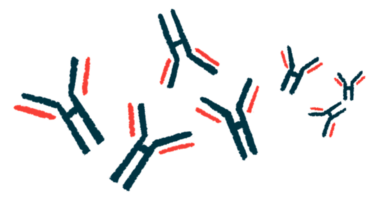RNA Molecules Targeting C5 Complement Protein May Be Effective in MG

Treatment with synthetic RNA molecules targeting the C5 complement system protein in the liver may be effective in people with myasthenia gravis (MG), according to a new study in rats, mice and monkeys. The findings also indicate that marked benefits may be achieved without frequent dosage.
The study, “Investigational RNAi Therapeutic Targeting C5 Is Efficacious in Pre-clinical Models of Myasthenia Gravis,” appeared in the journal Molecular Therapy — Methods & Clinical Developments.
Activation of the complement system — a set of more than 20 blood proteins that form part of the body’s immune defenses — has been implicated in MG development, both in patients and in animal models of the disease.
Preclinical studies suggested that complement blockade may be an effective treatment. Clinical trial results supported such findings, leading to the approval of Soliris (eculizumab, by Alexion Pharmaceuticals), an antibody therapy that blocks the liver-produced C5 protein, for adults with generalized MG.
However, patients with gene variants within the antibody-binding region of C5 may benefit more from other options. Also, regimens not requiring frequent dosage may be more convenient than the infusion of Soliris every two weeks.
Small interfering RNAs (siRNAs) regulate gene expression by targeting messenger RNA (mRNA), which is generated from DNA in protein production. siRNAs targeting C5 may be efficiently delivered to hepatocytes (liver cells) through binding to a molecule called N-acetylgalactosamine (GalNAc), which in turn binds the asialoglycoprotein receptor.
Studies in animals have indicated that subcutaneous — under-the-skin — administration of GalNAc-siRNAs leads to specific, robust, and durable suppression of multiple targets. Clinical trials of RNAi treatment candidates have further supported the potential of GalNAc-siRNAs as an effective therapy requiring infrequent dosing.
The scientists at Alnylam Pharmaceuticals and George Washington University developed GalNAc-siRNAs targeting C5, given via subcutaneous administration. They then tested the treatment’s impact on complement activity in healthy rodents, as well as its ability to ease the severity of the passive transfer (PT) and experimental autoimmune rat models of MG.
In mice and rats, the experimental treatment resulted in rapid, robust (over 85%) and sustained — up to at least day 70 — suppression of C5 production in the liver. In cynomolgus monkeys, the team found a dose-dependent suppression of serum C5 of up to 97.5% up to at least day 71, with a parallel inhibition of complement activity.
Also in monkeys, daily, weekly or twice-weekly administration of a 5 mg/kg dose resulted in similar decreases in serum C5 protein levels. Multiple injections led to greater reductions than single dosage (97.5% vs. 89.1%) and lessened hemolytic activity — the destruction of red blood cells — by at least 80% by day 32.
In the two rat models, C5 suppression through this RNA subtype effectively eased disease symptoms, with the higher dose (5 mg/kg) preventing muscle weakness and weight loss. Improvements were also seen when treatment was given after muscle weakness had already started.
A 10-fold reduction in liver C5 mRNA was found in the PT model. Serum C5 protein was reduced to less than 20% of baseline levels, while hemolytic activity was lowered by a minimum of 70% with the higher dose.
Also, treated rats showed higher density of acetylcholine receptors at the neuromuscular junction (NMJ) — the site where nerve cells and muscles communicate — and less accumulation of membrane attack complex (a sign of complement system activation) than untreated animals.
“Of critical importance is the observation that ablation of complement activity was not necessary to derive a therapeutic effect,” the researchers said.
Overall, “the pre-clinical studies of ALN-CC5 and efficacy of C5 silencing in rat models of MG support further clinical development of ALN-CC5 as a potential therapeutic for the treatment of MG and other complement-mediated disorders,” the scientists stated.






